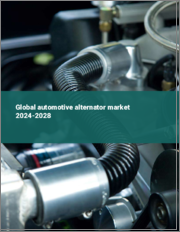
|
시장보고서
상품코드
1738071
자동차 얼터네이터 시장 규모, 점유율, 성장 분석 : 파워트레인별, 차량별, 단계별, 유형별, 판매 채널별, 지역별 - 산업 예측(2025-2032년)Automotive Alternator Market Size, Share, and Growth Analysis, By Power Train (ICE, Electric), By Vehicle (Passenger Cars, Commercial Vehicles), By Phase, By Type, By Sales Channel, By Region - Industry Forecast 2025-2032 |
||||||
자동차 얼터네이터 세계 시장 규모는 2023년에 253억 달러로 평가되었으며, 예측 기간(2025-2032년) 동안 CAGR 6.9%로, 2024년 270억 5,000만 달러에서 2032년에는 461억 2,000만 달러로 성장할 전망입니다.
자동차 얼터네이터 시장은 자동차 생산량 증가, 전자 기술 발전, 전기자동차(EV) 보급 및 연비 효율에 대한 관심 증가로 인해 성장할 것입니다. 수요를 충족시키기 위해 자동차 생산이 확대됨에 따라 발전에 필수적인 발전기 수요도 증가하고 있습니다. 완전 전기자동차는 전기 모터를 사용하지만, 하이브리드 및 플러그인 하이브리드 자동차는 여전히 배터리 충전 및 보조 시스템을 위해 교류발전기에 의존하고 있습니다. 발전기의 최신 기술 혁신은 에너지 변환을 강화하고 전반적인 연료 효율을 지원하는 것을 목표로 하고 있습니다. 전동식 파워 스티어링 및 첨단 안전장치와 같은 자동차의 전동화 추세와 함께 시장 수요는 확대될 것으로 예상됩니다. 그러나 고급 교류 발전기의 높은 비용과 새로운 파워트레인과의 통합의 어려움은 장기적인 시장 침투에 걸림돌이 될 수 있습니다.
목차
소개
- 조사 목적
- 조사 범위
- 정의
조사 방법
- 정보 조달
- 2차와 1차 데이터 방법
- 시장 규모 예측
- 시장 가정과 제한
주요 요약
- 세계 시장 전망
- 공급과 수요 동향 분석
- 부문별 기회 분석
시장 역학과 전망
- 시장 개요
- 시장 규모
- 시장 역학
- 성장 촉진요인과 기회
- 성장 억제요인과 과제
- Porters 분석
주요 시장 인사이트
- 핵심성공요인
- 경쟁 정도
- 주요 투자 기회
- 시장 생태계
- 시장 매력 지수(2024년)
- PESTEL 분석
- 거시경제 지표
- 밸류체인 분석
- 가격 분석
자동차 얼터네이터 시장 규모 : 파워트레인별 & CAGR(2025-2032년)
- 시장 개요
- 내연기관
- 전기
자동차 얼터네이터 시장 규모 : 차량별 & CAGR(2025-2032년)
- 시장 개요
- 승용차
- 상용차
자동차 얼터네이터 시장 규모 : 단계별 & CAGR(2025-2032년)
- 시장 개요
- 단상 교류 발전기
- 삼상 교류 발전기
자동차 얼터네이터 시장 규모 : 유형별 & CAGR(2025-2032년)
- 시장 개요
- 스타터 얼터네이터
- 충전 얼터네이터
- 보조 얼터네이터
자동차 얼터네이터 시장 규모 : 판매 채널별 & CAGR(2025-2032년)
- 시장 개요
- OEM
- 애프터마켓
자동차 얼터네이터 시장 규모 : 지역별 & CAGR(2025-2032년)
- 북미
- 미국
- 캐나다
- 유럽
- 독일
- 스페인
- 프랑스
- 영국
- 이탈리아
- 기타 유럽
- 아시아태평양
- 중국
- 인도
- 일본
- 한국
- 기타 아시아태평양
- 라틴아메리카
- 브라질
- 기타 라틴아메리카
- 중동 및 아프리카
- GCC 국가
- 남아프리카공화국
- 기타 중동 및 아프리카
경쟁 정보
- 상위 5개사의 비교
- 주요 기업의 시장 포지셔닝(2024년)
- 주요 시장 기업이 채용한 전략
- 최근의 시장 동향
- 기업의 시장 점유율 분석(2024년)
- 주요 기업 개요
- 기업 상세
- 제품 포트폴리오 분석
- 기업 부문별 점유율 분석
- 매출 전년비 비교(2022-2024년)
주요 기업 개요
- Denso Corporation(Japan)
- Valeo SA(France)
- Robert Bosch GmbH(Germany)
- Hitachi Astemo Ltd.(Japan)
- Continental AG(Germany)
- SEG Automotive(Germany)
- Prestolite Electric Incorporated(USA)
- BorgWarner Inc.(USA)
- Remy International, Inc.(USA)
- Cummins Inc.(USA)
- Lucas TVS Ltd.(India)
- Jumps Auto Industries Ltd.(India)
- Unipoint Electric MFG. Co., Ltd.(Taiwan)
- Nidec Corporation(Japan)
- Schaeffler AG(Germany)
- ZF Friedrichshafen AG(Germany)
결론과 제안
ksm 25.06.17Global Automotive Alternator Market size was valued at USD 25.3 billion in 2023 and is poised to grow from USD 27.05 billion in 2024 to USD 46.12 billion by 2032, growing at a CAGR of 6.9% during the forecast period (2025-2032).
The automotive alternator market is set for growth due to increasing automotive production, advancements in electronics technology, and a rising focus on electric vehicle (EV) adoption and fuel efficiency. As vehicle manufacturing ramps up to satisfy demand, the need for alternators, which are crucial for power generation, rises correspondingly. While fully electric vehicles utilize electric motors, hybrids and plug-in hybrids still depend on alternators for battery charging and auxiliary systems. Modern innovations in alternators aim to enhance energy conversion, supporting overall fuel efficiency. Alongside vehicle electrification trends like electric power steering and advanced safety mechanisms, market demand is expected to swell. However, challenges such as high costs of advanced alternators and integration difficulties with new powertrains may hinder long-term market penetration.
Top-down and bottom-up approaches were used to estimate and validate the size of the Global Automotive Alternator market and to estimate the size of various other dependent submarkets. The research methodology used to estimate the market size includes the following details: The key players in the market were identified through secondary research, and their market shares in the respective regions were determined through primary and secondary research. This entire procedure includes the study of the annual and financial reports of the top market players and extensive interviews for key insights from industry leaders such as CEOs, VPs, directors, and marketing executives. All percentage shares split, and breakdowns were determined using secondary sources and verified through Primary sources. All possible parameters that affect the markets covered in this research study have been accounted for, viewed in extensive detail, verified through primary research, and analyzed to get the final quantitative and qualitative data.
Global Automotive Alternator Market Segments Analysis
Global Automotive Alternator Market is segmented by Power Train, Vehicle, Phase, Type, Sales Channel and region. Based on Power Train, the market is segmented into ICE and Electric. Based on Vehicle, the market is segmented into Passenger Cars and Commercial Vehicles. Based on Phase, the market is segmented into Single-Phase Alternators and Three-Phase Alternators. Based on Type, the market is segmented into Starter Alternators, Charging Alternators and Auxiliary Alternators. Based on Sales Channel, the market is segmented into OEM and Aftermarket. Based on region, the market is segmented into North America, Europe, Asia Pacific, Latin America and Middle East & Africa.
Driver of the Global Automotive Alternator Market
The Global Automotive Alternator market is being significantly driven by the increasing integration of sophisticated electronic features in vehicles, including infotainment systems, autonomous driving technologies, and electric power steering. As automotive manufacturers strive to enhance energy efficiency, the demand for reliable and efficient alternators has surged, particularly due to the implementation of start-stop systems that require alternators to adapt to fluctuating load conditions. Additionally, the emergence of modern alternators equipped with regenerative capabilities plays a crucial role in optimizing power generation and enhancing fuel efficiency, further contributing to growth in this market as vehicles evolve towards more sustainable functionalities.
Restraints in the Global Automotive Alternator Market
The Global Automotive Alternator market is facing significant restraints due to the rise of alternative powertrains, particularly electric and hybrid vehicles. As fully electric vehicles (EVs) depend solely on battery power, they do not utilize traditional alternators, leading to a diminished need for these components. Moreover, certain hybrid vehicles replace conventional alternators with specialized power electronics and energy recovery systems. This shift towards electric mobility is expected to escalate, resulting in a decrease in demand for automotive alternators in the foreseeable future, ultimately impacting the market's growth and viability as consumer preferences evolve towards sustainable energy solutions.
Market Trends of the Global Automotive Alternator Market
The Global Automotive Alternator market is experiencing a significant shift towards lightweight and compact designs, driven by automotive manufacturers' commitment to reducing vehicle weight for enhanced efficiency and lower emissions. As the industry increasingly embraces hybrid and electric vehicle technology, the demand for smaller, more efficient alternators is surging. These innovations not only improve overall vehicle performance by minimizing energy consumption but also play a crucial role in meeting stringent emission regulations and corporate sustainability goals. As automakers prioritize carbon footprint reduction, the trend for advanced lightweight alternators is becoming vital in shaping the future landscape of the automotive industry.
Table of Contents
Introduction
- Objectives of the Study
- Scope of the Report
- Definitions
Research Methodology
- Information Procurement
- Secondary & Primary Data Methods
- Market Size Estimation
- Market Assumptions & Limitations
Executive Summary
- Global Market Outlook
- Supply & Demand Trend Analysis
- Segmental Opportunity Analysis
Market Dynamics & Outlook
- Market Overview
- Market Size
- Market Dynamics
- Drivers & Opportunities
- Restraints & Challenges
- Porters Analysis
- Competitive rivalry
- Threat of substitute
- Bargaining power of buyers
- Threat of new entrants
- Bargaining power of suppliers
Key Market Insights
- Key Success Factors
- Degree of Competition
- Top Investment Pockets
- Market Ecosystem
- Market Attractiveness Index, 2024
- PESTEL Analysis
- Macro-Economic Indicators
- Value Chain Analysis
- Pricing Analysis
Global Automotive Alternator Market Size by Power Train & CAGR (2025-2032)
- Market Overview
- ICE
- Electric
Global Automotive Alternator Market Size by Vehicle & CAGR (2025-2032)
- Market Overview
- Passenger Cars
- Commercial Vehicles
Global Automotive Alternator Market Size by Phase & CAGR (2025-2032)
- Market Overview
- Single-Phase Alternators
- Three-Phase Alternators
Global Automotive Alternator Market Size by Type & CAGR (2025-2032)
- Market Overview
- Starter Alternators
- Charging Alternators
- Auxiliary Alternators
Global Automotive Alternator Market Size by Sales Channel & CAGR (2025-2032)
- Market Overview
- OEM
- Aftermarket
Global Automotive Alternator Market Size & CAGR (2025-2032)
- North America (Power Train, Vehicle, Phase, Type, Sales Channel)
- US
- Canada
- Europe (Power Train, Vehicle, Phase, Type, Sales Channel)
- Germany
- Spain
- France
- UK
- Italy
- Rest of Europe
- Asia Pacific (Power Train, Vehicle, Phase, Type, Sales Channel)
- China
- India
- Japan
- South Korea
- Rest of Asia-Pacific
- Latin America (Power Train, Vehicle, Phase, Type, Sales Channel)
- Brazil
- Rest of Latin America
- Middle East & Africa (Power Train, Vehicle, Phase, Type, Sales Channel)
- GCC Countries
- South Africa
- Rest of Middle East & Africa
Competitive Intelligence
- Top 5 Player Comparison
- Market Positioning of Key Players, 2024
- Strategies Adopted by Key Market Players
- Recent Developments in the Market
- Company Market Share Analysis, 2024
- Company Profiles of All Key Players
- Company Details
- Product Portfolio Analysis
- Company's Segmental Share Analysis
- Revenue Y-O-Y Comparison (2022-2024)
Key Company Profiles
- Denso Corporation (Japan)
- Company Overview
- Business Segment Overview
- Financial Updates
- Key Developments
- Valeo SA (France)
- Company Overview
- Business Segment Overview
- Financial Updates
- Key Developments
- Robert Bosch GmbH (Germany)
- Company Overview
- Business Segment Overview
- Financial Updates
- Key Developments
- Hitachi Astemo Ltd. (Japan)
- Company Overview
- Business Segment Overview
- Financial Updates
- Key Developments
- Continental AG (Germany)
- Company Overview
- Business Segment Overview
- Financial Updates
- Key Developments
- SEG Automotive (Germany)
- Company Overview
- Business Segment Overview
- Financial Updates
- Key Developments
- Prestolite Electric Incorporated (USA)
- Company Overview
- Business Segment Overview
- Financial Updates
- Key Developments
- BorgWarner Inc. (USA)
- Company Overview
- Business Segment Overview
- Financial Updates
- Key Developments
- Remy International, Inc. (USA)
- Company Overview
- Business Segment Overview
- Financial Updates
- Key Developments
- Cummins Inc. (USA)
- Company Overview
- Business Segment Overview
- Financial Updates
- Key Developments
- Lucas TVS Ltd. (India)
- Company Overview
- Business Segment Overview
- Financial Updates
- Key Developments
- Jumps Auto Industries Ltd. (India)
- Company Overview
- Business Segment Overview
- Financial Updates
- Key Developments
- Unipoint Electric MFG. Co., Ltd. (Taiwan)
- Company Overview
- Business Segment Overview
- Financial Updates
- Key Developments
- Nidec Corporation (Japan)
- Company Overview
- Business Segment Overview
- Financial Updates
- Key Developments
- Schaeffler AG (Germany)
- Company Overview
- Business Segment Overview
- Financial Updates
- Key Developments
- ZF Friedrichshafen AG (Germany)
- Company Overview
- Business Segment Overview
- Financial Updates
- Key Developments
















